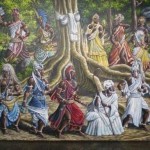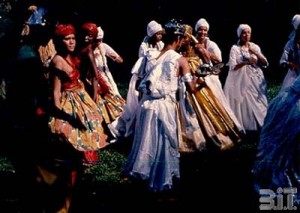The main ceremony of Santeria is the Bembé or “toque de Santos” as it is also known. The rite both begins and ends with prays to Elegguá
The ceremony resounds to the sound of the “atabales”. The “batas” drums beat incessantly. The “güiros” provide further background for the choir of voices which raises its chant to the dwelling place of the “orishas”. The faces of the worshipers seem transformed by the esoteric summons to possession. The gong of the atabales sounds louder. The odor of the jungle invades the place of worship. The chant grows louder on the Lucumí tongue:
“Ilá mi ilé oro…
“Ilá mi ilé oro…
“Iyá mi.
“Iyá mi, Saramawooooo
“Iyá mi ilé oro…
The sweating bodies shake in a frenzy with each beat of the drums. Legs, shoulders and bodies tremble as if reacting to an electric shock. A strange feeling of well-being invades every heart; it is visible in he emotion-twisted faces and the bleary eyes of the dancers. Their temples pound. At last –a body becomes possessed. A woman falls to the floor, her body jumping savagely, while from hundreds of throats the cry resounds.
“Gecua, Gey…”
This signifies the arrival of the saint. He has entered the body of a believer. He is among them and preparing to speak with the tongue of his “horse” and to dance in the physical form of his “instrument”.
If you were to ask the santero what happening, he would tell you that the saint has displaced the soul of the worshipper and occupied his body, to be able to communicate with men here on earth. The saint, he would tell you, is of spirit and space and lacks the physical attributes of a human…
Now the saint dances frenetically to the beat of the drums which incite him to further frenzied motion.
The Bembé has entered its moments of climax. Now everything is jungle –primitive, vigorous, fringed with omens and deep fears…
Before “departing”, the god will speak to the men, will advise hem on ways to preserve their health, to avoid “troubles”, to help others find employment. The god will also ask his due; he will demand a feat; he will even threaten his naughty “children”.
And when the saint has left the body of the “aleyo”, faith and belief will be stronger, and the body of the possessed will be sore in the aftermath of its frenzied contortions.
These are the origins of the diverse African belief still found in Cuba. They are everywhere on the island. A traces of Africanism remains in every Cuban, giving rise to a popular tune which goes:
“He who does not wear yellow (the color of Ochún).
“Covers himself with blue cloth (the color of Yemayá).
“Or red (belonging to Changó)”.
That is also the thought behind the proverb: “There are those who remember Saint Barbara when it thunders”.
For the same reason a politician once noted that “in Cuba the man who does not have an ancestor from the Congo has one from Carabalí…”
FelipeElosegui/CeremoniasA-C/InternetPhotos/thecubanhistory.com
AFRO-CUBAN santeria culture ceremony “THE BEMBE”
The Cuban History, Hollywood.
Arnoldo Varona, Editor
Foto por Maribel Romera Lopez – Amanecer desde el Malecon, La Havana.

CEREMONIAS AFRO-CUBANAS RITO EN SANTERIA “EL BEMBE”.
La principal ceremonia de santería es la Bembé o ” toque de Santos “, como también se le conoce . El rito tanto comienza y termina con ora a Elegguá.
La ceremonia resuena con el sonido de las ” atabales ” . Los tambores ” batas ” golpearon sin cesar. El ” güiros ” proporcionar más antecedentes para el coro de voces que eleva su canto a la morada de los ” orishas ” . Los rostros de los fieles parecen transformados por la citación esotéricas a la posesión . El gong de los atabales suena más fuerte . El olor de la selva invade el lugar de culto. El canto se hace más intenso en la lengua Lucumí :
” Ila mi ilé oro …
” Ila mi ilé oro …
” Iyá mi.
” Iyá mi, Saramawooooo
” Iyá mi ilé oro …
Los cuerpos sudorosos se dan en un frenesí con cada latido de los tambores. Las piernas, los hombros y los cuerpos tiemblan como si reaccionando a una descarga eléctrica. Una extraña sensación de bienestar invade todo corazón , sino que es visible en las caras que las emociones retorcidas y los ojos legañosos de los bailarines. Sus templos libras . Por fin , un cuerpo se poseía. Una mujer cae al suelo , su cuerpo saltando salvajemente , mientras que cientos de gargantas resuena el grito .
” Gecua , Gey … ”
Esto significa la llegada de la santa. Él ha entrado en el cuerpo de un creyente. Él es uno de ellos y se prepara para hablar con lengua de su “caballo ” y bailar en la forma física de su ” instrumento ” .
Si se le preguntara a la santero lo que pasa , él le diría que el santo ha desplazado el alma del adorador y ocupado su cuerpo, para poder comunicarse con los hombres en la tierra. El santo, que le diría, es de espíritu y el espacio y carece de los atributos físicos de un ser humano …
Ahora el santo baila frenéticamente al ritmo de los tambores que le incitan a un mayor movimiento frenético .
El Bembé ha entrado en sus momentos de clímax. Ahora todo es selva primitiva , vigoroso, con flecos de presagios y temores profundos …
Antes de ” salida ” , el dios hablará a los hombres , asesorará dobladillo en forma de preservar su salud, para evitar ” problemas ” , para ayudar a los demás a encontrar empleo. El dios también le pedirá que le corresponde , sino que exigirá una hazaña , sino que será incluso poner en peligro sus traviesos “niños” .
Y cuando el santo ha dejado el cuerpo de la ” aleyo ” , la fe y la creencia serán más fuertes , y el cuerpo de los posesos se llaga a raíz de sus frenéticas contorsiones .
Estos son los orígenes de las diversas creencias de África que todavía se encuentran en Cuba . Están por todas partes en la isla. Un rastro de africanismo permanece en cada cubano , dando lugar a una melodía popular que reza:
” El que no usar el color amarillo (el color de Ochún ) .
” Se cubre con una tela azul (el color de Yemayá ) .
” O rojo ( que pertenece a Changó ) ” .
Esa es también la idea detrás del proverbio : ” Los hay que recordar Santa Bárbara cuando truena ” .
Por la misma razón un político una vez que señaló que ” en Cuba el hombre que no tiene un antepasado del Congo tiene uno de Carabalí … ”
FelipeElosegui / CeremoniasA -C / InternetPhotos / thecubanhistory.com
AFRO- CUBAN ceremonia rito cultural en santería “EL BEMBE”
La Historia de Cuba , Hollywood.
Arnoldo Varona , Editor




